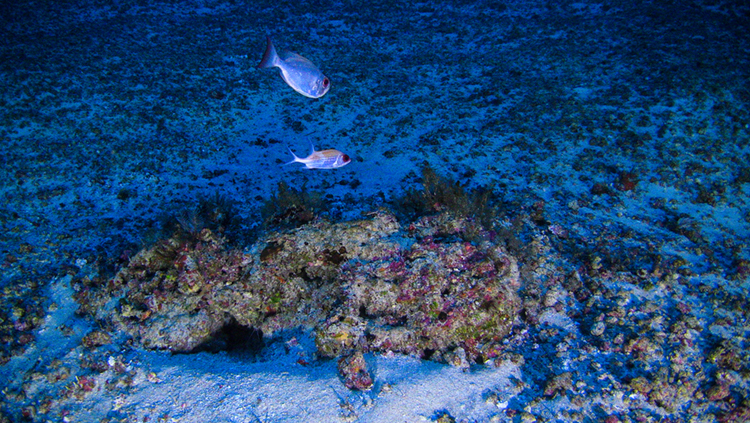^Top image: The Greenpeace ship Esperanza recovers its two-person research submarine from a dive to the Amazon Reef in February 2017. Scientists are just beginning to explore the recently discovered reef off the coast of Brazil. Credit: © Marizilda Cruppe, Greenpeace
Off the coast of Brazil, where the Amazon River spills into the Atlantic Ocean, scientists are taking the first up-close and personal look at the recently discovered Amazon Reef. Existence of the large coral reef was not confirmed until an oceanographic survey of the area in 2012. The survey’s findings were published in 2016, and in late January 2017, scientists began exploring the reef two-by-two in a small submarine, the exploration craft of the Greenpeace ship Esperanza.In the late 1950’s, a ship collected sponges—animals that often inhabit coral reefs—from the floor of the Amazon Delta. Because of the area’s oxygen-poor, murky-brown mix of freshwater and ocean saltwater, however, the possibility of a reef there was largely discounted. Coral reefs typically grow in clear saltwater that allows enough sunlight to support photosynthesis in their algae and plants. Photosynthesis is the process in which organisms use energy from sunlight to make food. In the following decades, colorful reef fish were spotted in the same part of the Amazon Delta, and speculation grew that a reef existed beneath the waves.

^Fish swim above the corals and sponges of the Amazon Reef off the coast of Brazil. This photograph is one of the first taken from a submarine launched by the Greenpeace ship Esperanza. Credit: © Greenpeac
Finally, in 2012, a team of oceanographers led by Rodrigo Moura of the Federal University of Rio de Janeiro, began studying the Amazon Delta’s sea floor. Using acoustic sampling, the researchers mapped the area, and subsequent dredging brought corals, sponges, and other reef species to the surface, proving the reef’s existence. After further study, the team published its findings in the journal Science Advances in April 2016.
The Amazon Reef stretches 600 miles (970 kilometers) along the Brazilian coast and covers an area of 3,600 square miles (9,300 square kilometers) with a depth range of 100 to 400 feet (30 to 120 meters). Since their first dive in late January 2017, oceanographers have turned the submarine’s lights on a wide variety of sea life, including three new fish species, rare manatees, yellow-spotted river turtles, and giant river otters. Given the Amazon Reef’s singular nature as the only known reef at the mouth of a major river, it may harbor many more undiscovered animals or plants as well. Further dives will help scientists learn how the reef functions and further define the ecology of the vast Amazon River Basin.
At a time when most reef systems are rapidly declining because of overfishing, pollution, and climate change, the discovery of a thriving reef in an unlikely place is encouraging. The reef is likely already in trouble, however, as oil companies are scouting the area and preparing to drill for oil. Drilling could severely harm the reef, as could any oil leaked into the delta waters.
Untitled Document Can't view the linked articles? Subscribe to World Book Online

World Book Online delivers a progressive sequence of core databases supported by supplemental
tools, such as language translation, graphic organizers, and unique Webquests. Moving from
Early World of Learning to World Book Advanced, World Book Online aligns end-users with their
appropriate learning levels. Each stand-alone site provides additional features to support the
needs of users’ specific capabilities.
The World Book Difference
World Book combines cutting-edge technology with traditional editorial excellence to produce
authoritative, trustworthy, and unbiased content. The digital content is updated in real time and
carefully curated for each learning level. Accessible 24/7, the content is available on a variety of devices.
World Book Online combines 21st-century instructional techniques with timely information.
By breaking down complex topics and using easily understandable text, World Book Online helps to
build fluency and increase comprehension. Featuring single sign-on capability, these sites are paired
with highly visual content to engage even the most reluctant reader. Our collection of resources kindles
a lifelong learning experience for every user. This adherence to clarity, currency, and accuracy makes
World Book’s digital offerings an information hub for the classroom, library, and beyond.